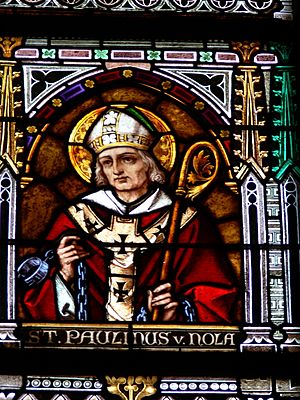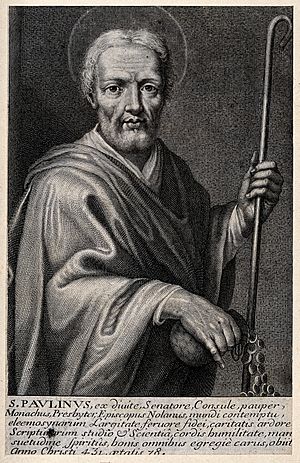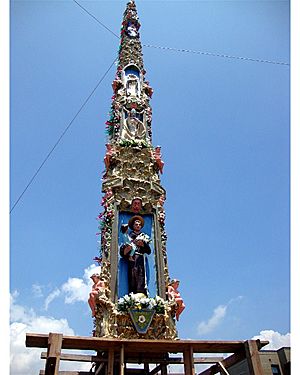Paulinus of Nola facts for kids
Quick facts for kids SaintPaulinus of Nola |
|
|---|---|
 |
|
| Bishop and Confessor | |
| Born | 22 June 354 Bordeaux, Gallia Aquitania, western Roman Empire |
| Died | 22 June 431 (aged 76–77) Nola in Campania, the Praetorian prefecture of Italy, Western Roman Empire |
| Venerated in | |
| Feast |
|
Paulinus of Nola (born Pontius Meropius Anicius Paulinus) was an important Roman poet, writer, and senator. He lived from about 354 to 431 AD. Paulinus was a high-ranking official in the Roman Empire, serving as a consul and governor.
Later in his life, he decided to leave his political career. He became a Christian and, after his wife Therasia passed away, he became the Bishop of Nola in Italy. He wrote many poems, especially honoring Saint Felix, and communicated with other Christian leaders. Paulinus is sometimes said to have introduced the use of bells in church services. He is honored as a Christian saint because he gave up his wealth to help others and live a religious life.
Contents
Life of Paulinus
Paulinus was born around 352 AD in Bordeaux, which is now in France. His family was very important and owned land in different parts of the Roman Empire. Paulinus was taught by the famous poet Ausonius, who also became his friend. When he was a boy, he visited the shrine of Saint Felix in Nola, Italy.
Paulinus had a successful career as a young Roman senator. Around 377 AD, Emperor Gratian made him a consul in Rome. Then, around 380 AD, he became the governor of Campania in southern Italy. Paulinus noticed how much the people of Campania respected Saint Felix. He even built a road for pilgrims and a place for poor people near Saint Felix's shrine.
In 383 AD, Emperor Gratian was killed. Paulinus then went to Milan to study with Ambrose, a famous Christian leader. Around 384 AD, he returned to Bordeaux and married Therasia, a Christian noblewoman. Paulinus faced false accusations of harming his brother. He was baptized as a Christian by Bishop Delphinus of Bordeaux.
Around 390 AD, Paulinus and Therasia moved to Spain. They had a child who sadly died just eight days after birth. After this, they decided to live a quiet, religious life.
Becoming a Priest and Bishop
In 393 or 394 AD, Paulinus became a presbyter (a type of priest) in Barcelona. This was a bit unusual because he became a priest very quickly, without going through all the usual steps first. However, Paulinus did not want to stay in Barcelona. In 395 AD, he and Therasia moved to Nola in Campania, Italy. He lived there until he died. Paulinus believed that Saint Felix had inspired his conversion to Christianity. Every year, he wrote a poem to honor Saint Felix.
Around 402-403 AD, Paulinus started big building projects in Nola. He repaired and improved the old church built for Saint Felix. He and Therasia also built a large, beautiful new church with grand entrances and fountains. Many pilgrims came to visit Saint Felix's tomb.
Paulinus also wrote many letters to other Christian leaders, like Jerome and Augustine. He believed in using his money to help the poor and the church.
Therasia died sometime between 408 and 410 AD. Soon after, Paulinus became the Bishop of Nola. He served as bishop for twenty years. Like many wealthy people at that time who joined the church, Paulinus spent a lot of his money on his church and city.
Paulinus died in Nola on June 22, 431 AD.
Paulinus's Impact
As the Bishop of Nola, Paulinus is often said to have introduced the use of bells in church services. This is why some old bells were called nola and church tower bells were called campanas, after the region of Campania. However, some historians say that bells were used in churches before Paulinus.
Paulinus greatly admired Felix of Nola, a local saint. Felix's tomb was in Cimitile, just outside Nola. As governor, Paulinus had improved the road to Cimitile and built a place for travelers. This is where Paulinus and Therasia lived. Paulinus rebuilt the church complex there, building a new church for Felix and starting a small religious community. He wrote a special hymn each year for Saint Felix's feast day, when many pilgrims visited. His poems show his deep personal connection to Felix.
Many of Paulinus's letters to his friends and other important figures have been saved. These include letters to Ausonius and Sulpicius Severus in France, and Augustine in Africa. Augustine often sent copies of his writings to Paulinus to be shared in Italy. Paulinus's letters and poems tell us about his beliefs, his friendships, and how Christian ideas influenced Latin writing. They also show how the worship of saints grew during that time.
Paulinus also described his building projects in detail, especially the church for Saint Felix. He wrote about the apse mosaic above the main altar and the words he wrote to go on the wall. He explained that he wanted the pictures to help visitors understand the sacred stories. He said, "It seemed to us useful to portray sacred themes in painting throughout the house of Felix, in the hope that when the peasants see the painted figure, these images will awaken interest in their astonished minds."
Later in his life, Paulinus was a respected church leader. He took part in church meetings that discussed important religious issues of his time.
A Famous Story
Gregory the Great, a later Pope, tells a popular story about Paulinus. When the Vandals attacked Campania, a poor widow asked Paulinus for help. Her only son had been taken captive by the Vandal king's son-in-law. Paulinus had already used all his money to free other captives. So, he offered himself in exchange for the widow's son. Paulinus went to Africa and worked as a gardener.
Eventually, the Vandal king found out that his son-in-law's slave was the famous Bishop of Nola. The king immediately set Paulinus free. He also freed all the people from Nola who had been taken captive. Pope Benedict XVI said that while the exact details of this story might be debated, it shows Paulinus as a bishop with a big heart who cared deeply for his people during difficult times.
Saint Paulinus's Relics
Around 800 AD, Prince Grimoald III of Benevento moved Paulinus's bones, which are considered relics.
From the 11th century, they were kept in a church in Rome. In 1908, Pope Pius X allowed them to be moved back to the new cathedral in Nola. They were reburied there on May 15, 1909.
Today, some of his bones are also found in the small city of Sutera in Sicily. They celebrate a feast day and have a procession for the saint there every Easter.
Honoring Saint Paulinus Today
People in Nola and nearby areas still honor Saint Paulinus very much. His feast day is celebrated every year in Nola with "La Festa dei Gigli" (the Feast of the Lilies). During this festival, large towers called Gigli, with statues of the saint, are carried on the shoulders of people through the city. In the United States, descendants of Italian immigrants from Nola continue this tradition in places like Brooklyn and East Harlem in New York City.
Paulinus is also honored in the Eastern Orthodox Church. His feast day there is on January 23.
See also
 In Spanish: Paulino de Nola para niños
In Spanish: Paulino de Nola para niños




